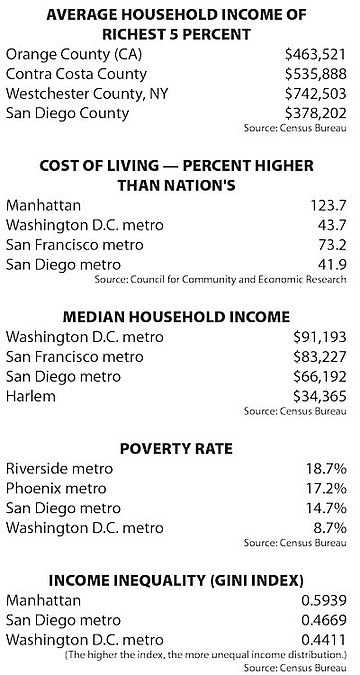 Facebook
Facebook
 X
X
 Instagram
Instagram
 TikTok
TikTok
 Youtube
Youtube

In mid-September, the United States Census Bureau published its annual report on income and poverty throughout the nation. I spent days culling the new data for 2014, wondering if the San Diego metropolitan area (the county) would finally rise to the level of a statistical aristocrat — that is, rich by national standards.
No such luck. But no bad news, either. San Diego’s metropolitan area enjoys a fairly high income among its peers, but it also has a high cost of living. It’s called “psychic income” — moderately high pay, very high cost of living, perfect weather.
The Gini index, or measurement of income inequality, is not bad at all. Money is fairly evenly distributed in the county. A handful of affluent families may have most of the political power, but they don’t have all the money.

“San Diego is in the middle” among the largest metro areas in income inequality, says Peter Brownell, research director of the Center on Policy Initiatives. However, he points out that San Diego’s poverty rate is essentially the same as it was in 2013, despite significant job growth and a sharp decline in the unemployment rate.
The county’s poverty rate last year was 14.7 percent overall, according to the 2014 statistics released last month. Eleven of the 25 largest metro areas have a higher rate: Los Angeles’ rate is 17.3 percent and Riverside/San Bernardino’s 18.7 percent. San Diego’s child poverty rate of 18.9 percent is topped by 13 of the 25 metro areas’ rates; Riverside’s is the worst at 26 percent.
“What we’ve seen is that the poverty rate went up considerably during the recession and has come down a bit, but in the last few years has been pretty much stagnant in terms of coming down further,” says Brownell. “We found that surprising, considering the improvement in employment, in the jobs that we’ve added. Even though we were adding jobs, we lost middle-income jobs and gained lower-income jobs.”
According to the Census Bureau, San Diego’s median household income last year was $66,192, handily topping the nation’s $53,657. Only 8 of the nation’s largest 25 metro areas (Baltimore, Boston, Denver, Minneapolis, New York, San Francisco, Seattle, and Washington, DC) had higher median household incomes last year.
Don’t celebrate yet. According to data from the Council for Community and Economic Research, San Diego’s cost of living is 41.9 percent higher than the nation’s. That’s third highest among the nation’s largest metro areas. The highest is San Francisco’s at 73.2 percent above the nation’s. San Francisco’s median household income is $83,222, or 55 percent above the nation’s. San Diego’s income is 23 percent higher than the nation’s.

So, San Diego’s household income is 23 percent higher than the nation’s, but cost of living is 41.9 percent higher. San Francisco’s income is 55 percent higher, but living costs are 73.2 percent higher. “The ratio between income and cost of living in both cities is about the same,” says Kelly Cunningham, economist for the National University System Institute for Policy Research.
People are warned not to move to San Francisco because it is so expensive. But is it? It has higher incomes to offset its very high cost of living. On balance, it may be no more expensive than San Diego, although housing would be a major exception. San Diego’s median home price is above $500,000 and San Francisco’s is above $800,000. According to advisorperspectives.com, buying a median-priced home in San Diego requires a salary of $104,800. In San Francisco, it takes $157,900.

Income inequality is a hot topic these days. The Gini coefficient, or index, is the best measure of it. A Gini coefficient of zero expresses perfect equality — everyone makes the same amount of money. A Gini of 1 expresses the reverse — one person makes all the money.
The Gini index is often applied to countries. For example, the Seychelles, a group of islands in the Indian Ocean, has a number of rich people because of its attraction as a tourist haven for the rich and a tax, secrecy, and money-laundering haven for rascals. Because many are poor, it has a high Gini index, above 0.65. South Africa, a nation in which rich white people dominate poor blacks, has a high Gini coefficient — around 0.65.
That’s not news to Cunningham, a Mormon, who went on a two-year mission to South Africa in the 1970s, while apartheid was in effect. “The whites were considered citizens and the blacks were not considered citizens,” he says. “There was clearly an unequal distribution of income, concentrated among the whites.”
According to the new census data, the United States had a Gini of 0.48 last year. Manhattan has an extremely high Gini of 0.5939 — hardly surprising, because it includes all the superrich living in the high-rise condos and cooperatives (its housing costs are 345 percent higher than the nation’s), and it also includes Harlem, with a median household income of $34,365, less than half that of Minneapolis. Another high Gini index area is Fairfield County, Connecticut, with its fabled Gold Coast filled with hedge-fund operators in glitzy towns such as New Canaan, Darien, and Greenwich. It has a Gini coefficient of 0.5491.
The San Diego metro area’s Gini coefficient last year was 0.4669, below the nation’s. The metro areas of Los Angeles (Gini 0.4981) and San Francisco (0.4892) exceeded the nation, but not by much.
Finally, if you want a cushy life, be a bureaucrat, lobbyist, politician, or hanger-on around the federal government. The poverty rate for the Washington DC metro area is only 8.7 percent. The median household income is $91,193, by far the highest of the 25 largest metro areas. But you only need household income of $83,000 to buy a median-priced home. The cost of living is 43.3 percent higher than the nation’s, but incomes are 70 percent higher. The Gini index is 0.4411, an indication that the Beltway folks share the income and wealth — it’s not concentrated in a few hands.
After all, the president of the United States makes only $400,000. That’s while he or she is president. Upon leaving office, presidents get very rich — and usually move from Washington.


In mid-September, the United States Census Bureau published its annual report on income and poverty throughout the nation. I spent days culling the new data for 2014, wondering if the San Diego metropolitan area (the county) would finally rise to the level of a statistical aristocrat — that is, rich by national standards.
No such luck. But no bad news, either. San Diego’s metropolitan area enjoys a fairly high income among its peers, but it also has a high cost of living. It’s called “psychic income” — moderately high pay, very high cost of living, perfect weather.
The Gini index, or measurement of income inequality, is not bad at all. Money is fairly evenly distributed in the county. A handful of affluent families may have most of the political power, but they don’t have all the money.

“San Diego is in the middle” among the largest metro areas in income inequality, says Peter Brownell, research director of the Center on Policy Initiatives. However, he points out that San Diego’s poverty rate is essentially the same as it was in 2013, despite significant job growth and a sharp decline in the unemployment rate.
The county’s poverty rate last year was 14.7 percent overall, according to the 2014 statistics released last month. Eleven of the 25 largest metro areas have a higher rate: Los Angeles’ rate is 17.3 percent and Riverside/San Bernardino’s 18.7 percent. San Diego’s child poverty rate of 18.9 percent is topped by 13 of the 25 metro areas’ rates; Riverside’s is the worst at 26 percent.
“What we’ve seen is that the poverty rate went up considerably during the recession and has come down a bit, but in the last few years has been pretty much stagnant in terms of coming down further,” says Brownell. “We found that surprising, considering the improvement in employment, in the jobs that we’ve added. Even though we were adding jobs, we lost middle-income jobs and gained lower-income jobs.”
According to the Census Bureau, San Diego’s median household income last year was $66,192, handily topping the nation’s $53,657. Only 8 of the nation’s largest 25 metro areas (Baltimore, Boston, Denver, Minneapolis, New York, San Francisco, Seattle, and Washington, DC) had higher median household incomes last year.
Don’t celebrate yet. According to data from the Council for Community and Economic Research, San Diego’s cost of living is 41.9 percent higher than the nation’s. That’s third highest among the nation’s largest metro areas. The highest is San Francisco’s at 73.2 percent above the nation’s. San Francisco’s median household income is $83,222, or 55 percent above the nation’s. San Diego’s income is 23 percent higher than the nation’s.

So, San Diego’s household income is 23 percent higher than the nation’s, but cost of living is 41.9 percent higher. San Francisco’s income is 55 percent higher, but living costs are 73.2 percent higher. “The ratio between income and cost of living in both cities is about the same,” says Kelly Cunningham, economist for the National University System Institute for Policy Research.
People are warned not to move to San Francisco because it is so expensive. But is it? It has higher incomes to offset its very high cost of living. On balance, it may be no more expensive than San Diego, although housing would be a major exception. San Diego’s median home price is above $500,000 and San Francisco’s is above $800,000. According to advisorperspectives.com, buying a median-priced home in San Diego requires a salary of $104,800. In San Francisco, it takes $157,900.

Income inequality is a hot topic these days. The Gini coefficient, or index, is the best measure of it. A Gini coefficient of zero expresses perfect equality — everyone makes the same amount of money. A Gini of 1 expresses the reverse — one person makes all the money.
The Gini index is often applied to countries. For example, the Seychelles, a group of islands in the Indian Ocean, has a number of rich people because of its attraction as a tourist haven for the rich and a tax, secrecy, and money-laundering haven for rascals. Because many are poor, it has a high Gini index, above 0.65. South Africa, a nation in which rich white people dominate poor blacks, has a high Gini coefficient — around 0.65.
That’s not news to Cunningham, a Mormon, who went on a two-year mission to South Africa in the 1970s, while apartheid was in effect. “The whites were considered citizens and the blacks were not considered citizens,” he says. “There was clearly an unequal distribution of income, concentrated among the whites.”
According to the new census data, the United States had a Gini of 0.48 last year. Manhattan has an extremely high Gini of 0.5939 — hardly surprising, because it includes all the superrich living in the high-rise condos and cooperatives (its housing costs are 345 percent higher than the nation’s), and it also includes Harlem, with a median household income of $34,365, less than half that of Minneapolis. Another high Gini index area is Fairfield County, Connecticut, with its fabled Gold Coast filled with hedge-fund operators in glitzy towns such as New Canaan, Darien, and Greenwich. It has a Gini coefficient of 0.5491.
The San Diego metro area’s Gini coefficient last year was 0.4669, below the nation’s. The metro areas of Los Angeles (Gini 0.4981) and San Francisco (0.4892) exceeded the nation, but not by much.
Finally, if you want a cushy life, be a bureaucrat, lobbyist, politician, or hanger-on around the federal government. The poverty rate for the Washington DC metro area is only 8.7 percent. The median household income is $91,193, by far the highest of the 25 largest metro areas. But you only need household income of $83,000 to buy a median-priced home. The cost of living is 43.3 percent higher than the nation’s, but incomes are 70 percent higher. The Gini index is 0.4411, an indication that the Beltway folks share the income and wealth — it’s not concentrated in a few hands.
After all, the president of the United States makes only $400,000. That’s while he or she is president. Upon leaving office, presidents get very rich — and usually move from Washington.
Comments